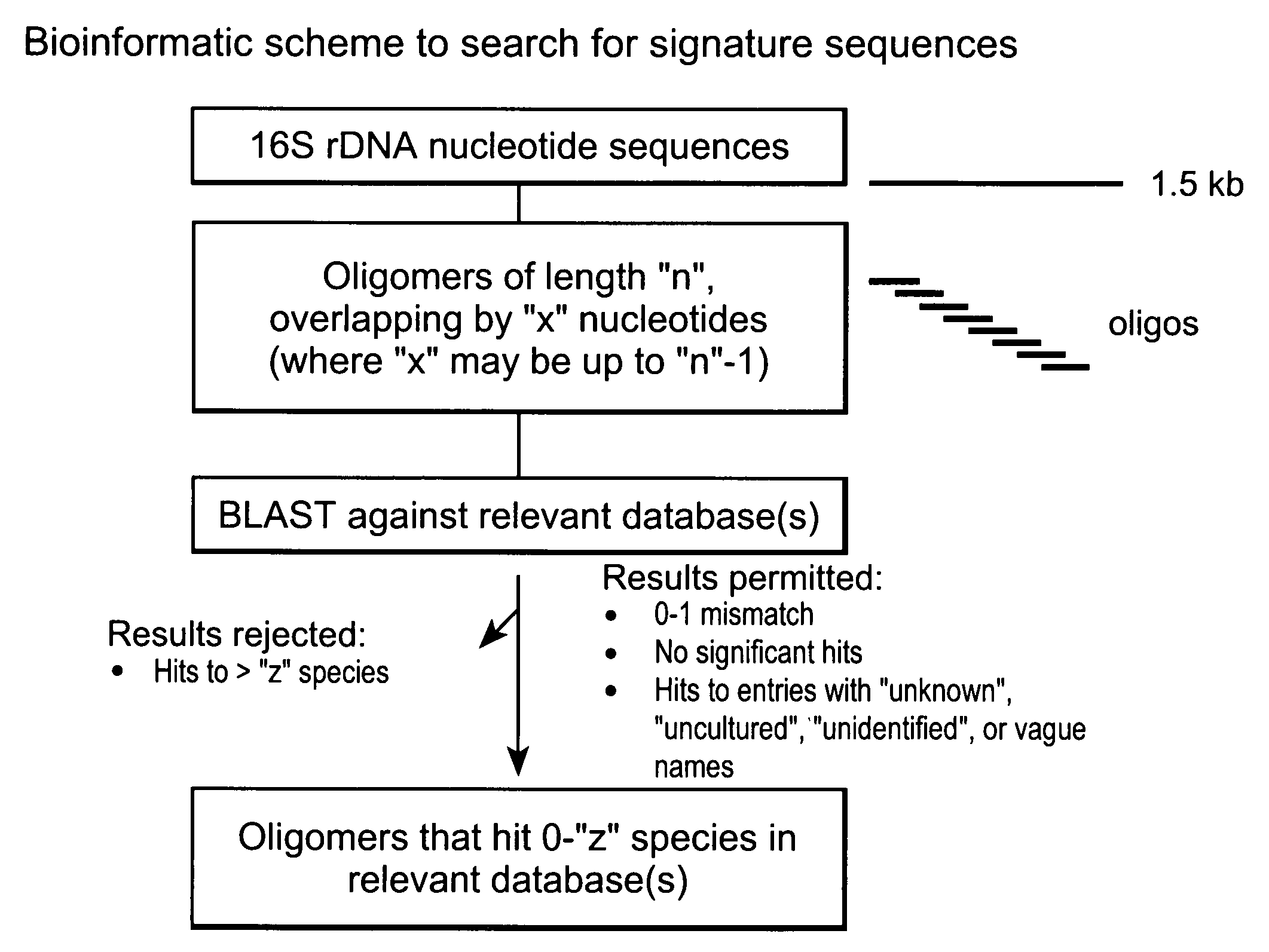Genus, group, species and/or strain specific 16S rDNA sequences
a technology of rdna sequences and species, applied in the field of genus, group, species and/or strain specific 16s rdna sequences, can solve the problems of difficult to find probes that distinguish between closely related species and strains of organisms, the specificity of the specificity of the specificity of the inability to precisely detect the specificity of the 16s rdna sequences
- Summary
- Abstract
- Description
- Claims
- Application Information
AI Technical Summary
Benefits of technology
Problems solved by technology
Method used
Image
Examples
example 1
Sequencing of 16S rRNA
[0254] Direct sequencing of uncloned PCR generated template for variant sequence discovery is described by, for example, Wrischnik et al., 1987 Nuc. Acids Res. 15(2): 529-42; Gibbs et al., 1989 Proc. Nat'l Acad. Sci. USA 86(6): 1919-23; and Rogall et al., 1990 J. Gen. Microbiol. 136(Pt 9): 1915-20. This method has been applied to both prokaryotic and eukaryotic systems. Software to support this process is widely available (Nickerson et al., 1997 Nuc. Acids Res. 25(14): 2745-51). We have adapted this strategy for discovery of 16S RNA variation in numerous bacterial species.
[0255] PCR primers for amplification of the 16S rRNA gene were designed using the E. coli (ATCC11775) and S. aureus (ATCC12066) 16S rDNA sequences. Three tiers of amplicons were designed for complete coverage of the 16S gene as demonstrated in FIG. 1. Tier one has three overlapping fragments. Tier two has two fragments, and tier three has a single fragment. Primer sequences are noted in Tabl...
example 2
Identification of Species-specific Oligonucleotide Sequences Computationally Using 30-mers with 15 Nucleotide Overlaps
[0260] DNA sequences of the 16S ribosomal loci of 1,214 bacterial samples representing 545 different species were generated and stored in an internal database. As outlined in the schematic diagram of FIG. 2, these sequences were processed in silico to yield 132,325 fragments of 30 nucleotides (nt) in length with a 15 nt (n=15) overlap. These fragments were compared against sequence databases, and the BLAST reports were parsed to discover oligonucleotides that matched a portion of the 16S rDNA sequence of a bacterial species with a criterion of permitting no more than 1 mismatch. Fragments that met this criterion and only matched one or zero species (or unidentified / uncultured / unknown entries) within that criterion were called “species-specific oligos”. This examination was conducted on three databases, the internal database described above, GenBank, and RDP. The res...
example 3
Identification of Species-specific Oligonucleotide Sequences Computationally Using 20-mers with 19 Nucleotide Overlaps
[0263] DNA sequences of the 16S ribosomal loci of 1,324 bacterial samples representing 585 different species were processed in silico to yield 1,859,805 fragments of 20 nucleotide (nt) each, with an overlap of 19 nt (n=19). A pair-wise comparison was conducted using BLAST on the fragments against the Ribosomal Database Project (RDP) database. The BLAST reports generated from the comparisons were parsed using PERL programming language to identify oligonucleotides that matched a portion of the 16S rDNA sequence of a bacterial species with a criterion of permitting no more than 1 mismatch. Fragments that met this criterion and only matched one or zero species (or unidentified / uncultured / unknown entries) within that criterion were called “species-specific oligos”. The analysis discovered 90,079 fragments that met this criterion in RDP database. These 90,079 fragments we...
PUM
| Property | Measurement | Unit |
|---|---|---|
| Tm | aaaaa | aaaaa |
| Tm | aaaaa | aaaaa |
| Tm | aaaaa | aaaaa |
Abstract
Description
Claims
Application Information
 Login to View More
Login to View More - R&D
- Intellectual Property
- Life Sciences
- Materials
- Tech Scout
- Unparalleled Data Quality
- Higher Quality Content
- 60% Fewer Hallucinations
Browse by: Latest US Patents, China's latest patents, Technical Efficacy Thesaurus, Application Domain, Technology Topic, Popular Technical Reports.
© 2025 PatSnap. All rights reserved.Legal|Privacy policy|Modern Slavery Act Transparency Statement|Sitemap|About US| Contact US: help@patsnap.com



